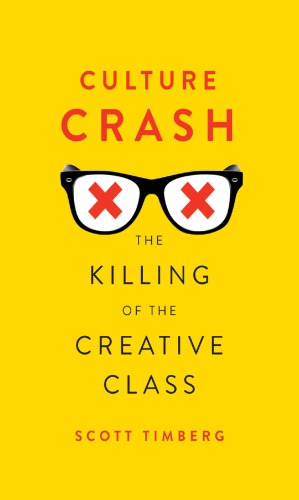
Culture Crash
The Killing of the Creative Class
کتاب های مرتبط
- اطلاعات
- نقد و بررسی
- دیدگاه کاربران
نقد و بررسی

November 10, 2014
In this collection of essays based on articles that originally appeared in Salon, Timberg laments the loss of an industry that afforded graphic artists, roadies, editors, cartoonists, and journalists a middle-class life. The book ambitiously tackles the waning of many forms of “culture,” including indie rock, architecture, and book publishing. Inevitably culture was better in “the past,” and Timberg takes readers back to the days when poetry had a huge audience and Los Angeles had a vibrant art scene. He furthers his argument for the decline of the creative middle class by contrasting the success of mega-hit music producer Dr. Luke with contemporary struggling poet and musician Chris Stroffolino. He argues that the U.S. has become a “winner-take-all” society that forces the creative class into a culture where only blockbusters succeed. Timberg cites the disappearance of clerks at physical record and book stores as a greater loss for the whole culture. Ultimately, Timberg is long on complaints but short on solutions, and he consistently overlooks or dismisses “digital technology” in the process. The book successfully documents the lost economic opportunities of an artistic society, but offers only vague suggestions for improving the lot of workers in the arts. Agent: David Patterson, Foundry Literary + Media.

November 1, 2014
A journalist investigates the state of the arts.Anger infuses ArtsJournal editor Timberg's (co-author, Misread City: New Literary Los Angeles, 2003) report on threats to the "creative class," which he defines, broadly, as "anyone who helps create or disseminate culture," including artists, musicians, librarians and architects, as well as "their often-mocked supporting casts-record store clerks, roadies, critics, publicists, and supposedly exploitative record label folk...deejays, bookstore clerks, theater and set designers, people who edit books in publishing houses, and so on." The author, who lost his job as a reporter at the Los Angeles Times as a result of downsizing, has found that many others like him-creative types wanting only to support themselves and their families- have been hurt since the recession began in 2008. Some have been forced into the "gig economy," fighting "to keep a home, a livelihood, or medical coverage" while taking low-paying freelance jobs. Free agency, rather than allowing people "to live flexible and self-determining lives full of meaning," instead makes their lives precarious. Among forces undermining the creative class are the culture of celebrity, corporations' emphasis on the monetary return of arts and entertainment, and growing income inequality. In academia, the author contends that the professoriate "is de-professionalized the same way journalism has been," with adjuncts replacing tenured professors and a few superstars hired to teach thousands of students in profitable online courses. In response to his dismal findings, Timberg offers a few ardent but vague suggestions: "stirring passion for culture in schoolkids and college students"; inspiring academics to address readers outside of their narrow fields; expanding "midlist" offerings by book publishers and movie companies; and reviving vigorous public support for culture. Timberg's bibliographic essay cites many authors echoing his arguments; a more focused analysis and concrete solutions would have strengthened this book.
COPYRIGHT(2014) Kirkus Reviews, ALL RIGHTS RESERVED.

























دیدگاه کاربران